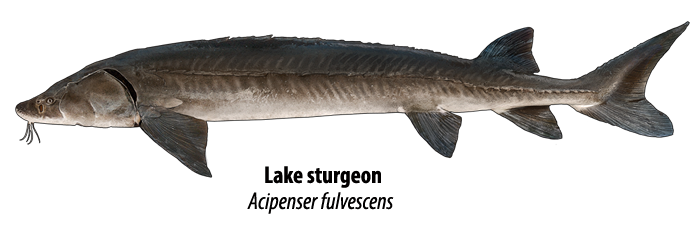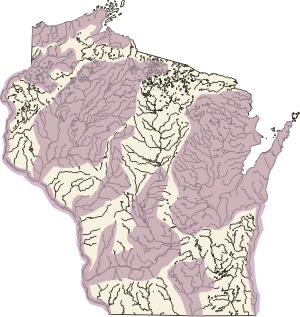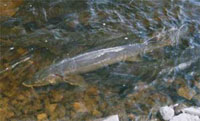Lake sturgeon
Fishing Wisconsin
A giant among Wisconsin's inland freshwater fishes, the bottom-dwelling lake sturgeon is a living fossil - a relic from the Middle Ages of fish evolution. This ancient species made its first appearance about 100 million years ago in the Upper Cretaceous period of the Mesozoic era, just about the time that the dinosaurs made their abrupt exit from Earth's ever-changing stage. Today the lake sturgeon retains many primitive characteristics that have been lost or modified in other modern-day fishes.
Identification
With its heavy, torpedo-shaped body thick in front and tapering toward the turned-up tail in back, the young sturgeon resembles a shark but lacks the overall sleekness of the revered marine dweller. As befits a representative of fishdom's medieval era, the lake sturgeon wears "armor" in the form of bony, shell-shaped plates, or scutes, arranged in five rows - two on each side and one along the back - that run along the length of the body. Each scute comes to a peak with a sharp-pointed spur. As the fish grows older, the rows of spine-tipped bony scutes smooth out; on old, large individuals the scutes are barely visible and the fish appears relatively smooth. The sturgeon have never evolved to the point of replacing the cumbersome plates with smaller, thinner, flexible scales found on more modern species of fish.
While the lake sturgeon isn't likely to be mistaken for Jaws, it does have a heterocercal (sharklike with the upper lobe being longer than the lower) caudal (tail) fin. And instead of a backbone with separate vertebrae, the sturgeon has a continuous, flexible, cartilage-encased rod called a notochord that runs the length of the body and ends at the tip of the upper lobe in the tail fin.
Lake sturgeon have long, tapering snouts that become shorter and blunter with age. Four barbels, or feelers, dangle in a row on the lower side of the snout just in front of the mouth. The barbels are important sensory organs that alert the fish to the presence of food as the fish coasts slowly over the bottom. The mouth and lips of the lake sturgeon protrude to suck up food and retract when not in use - and this venerable fish need never fear a trip to the dentist, since it has no teeth. Two spiracles (vents) are located on top of the head just forward of the gills.
Lake sturgeon exhibit considerable color variation due to age and differences in the locality. Wisconsin's lake sturgeon are generally slate-gray, olive-brown or black over the body with a milky or yellow-white underside. Young lake sturgeon are usually lighter in color than the adults and have dark blotches on their sides and snouts.
Distribution
The lake sturgeon occurs in the Mississippi, Lake Michigan, and Lake Superior drainage basins. In the Mississippi River drainage it occurs in the Mississippi, St. Croix, Chippewa (and major tributaries), and Wisconsin rivers. In the Wisconsin River, records place it upstream to the Castle Rock Flowage (Adams County). In Lake Superior it is found in the comparatively shallow waters of Keweenaw Bay, in the vicinity of the Apostle Islands, and it is known to spawn in the Bad River (Ashland County). It has been occasionally taken in St. Louis Bay. In the Lake Michigan basin it occurs in Green Bay, Lake Michigan, the Menominee River upstream to the White Rapids Dam, the Fox River upstream to Lake Puckaway, and the Wolf River upstream to Shawano. This system includes Lakes Winnebago, Butte des Morts, and Winneconne, and the Embarrass River. It has been introduced to lakes where natural reproduction did not occur, among them: Big Cedar Lake (Washington County), the Madison lakes (Dane County), Chain of Lakes (Waupaca County), and Pear Lake (Washburn County). The lake sturgeon is listed as a rare species in the United States. Over most of its range in the United States, it appears to be threatened. In Wisconsin, it is common in the Menominee River, the lower Wolf River, Lakes Poygan and Winnebago, Lake Wisconsin, the St. Croix River to Gordon Dam, Namekagon River below Trego Dam, and the Chippewa and Flambeau rivers. It is uncommon to rare in the lower Wisconsin River, Mississippi River, the Madison lakes, and Lakes Michigan and Superior.
Habits and Habitat
Without teeth, it's hard for the lake sturgeon to put the bite on anything bigger than the occasional crayfish. Because they rely on suction to feed, lake sturgeon are restricted to living on small organisms - snail, insect larvae, leeches, small clams, and other invertebrates. To locate these delectable creatures, the lake sturgeon must linger at the bottom of lakes with extensive areas of shallow water (less than 30 feet) and in deep river pools, foraging where food is abundant.
When it is searching for food, a lake sturgeon will drag its barbels lightly over the bottom. As soon as these sensitive feelers touch food, the fish protrudes its tubular mouth and sucks up the food along with silt, gravel, and other bottom materials. The debris is expelled through the gills and the food items remain.
Lake sturgeon have the curious but spectacular habit of leaping completely out of the water until they appear to be standing on their tails, then landing with a resounding splash. Fish experts theorize that the sturgeon may be trying to shake off lampreys; most adult sturgeon have one or more old lamprey scars and it is not uncommon to see six or more lampreys attached to one fish.
Reproduction and Development
Lake sturgeon migrate to their annual spawning grounds between late April and early June, preferring to spawn in shallow, rocky areas along river banks. Sturgeon spawning is dependent on water temperature and flow. During seasons when water flow is high and water temperatures rise slowly spawning begins when the water temperature reaches 53 degrees F. In contrast, during seasons of low water flow and more rapid water temperature rise, spawning does not begin until water temperatures reach 58-59 degrees F. Annual Sturgeon Spawning Information
Males arrive at the spawning sites ahead of the females, cruising in groups of eight or more, often so close to the surface that their tails, backs, or snouts are out of the water. Spawning begins as soon as a ripe (sexually ready) female enters the group. The males swim alongside the female, usually against the current, vigorously thrashing their tails as they release milt (sperm) while the female drops her eggs. The fertilized eggs, each about one-eighth inch in diameter, are sticky and cling to rocks and other solid materials in the water until they hatch. There is considerable variation in the number of eggs produced by the females of the same weight - the quantity can range from 50,000 to 700,000 eggs in one season.
The eggs hatch in five to eight days, depending on the water temperature. In 12 to 14 days, the fry (newly hatched fish) are one inch long and have fully developed mouths and barbels.
Spawning frequency - A female sturgeon reaches sexual maturity when she is 24 to 26 years old and about 55 inches long, and will spawn once every four, five, or six years thereafter. Males mature at about 15 years, when they are about 45 inches long. Most males spawn every other year, while some do so every year.
Lake sturgeon grow larger and live longer than any other fish in Wisconsin. An 82-year-old caught in Lake Winnebago in 1953 is on record as the oldest lake sturgeon in Wisconsin - a mere whippersnapper, when compared to the 152-year-old, 215-pound, 81-inch long old-timer, hauled up from the bottom of Lake of the Woods in Ontario, Canada that same year.
At first, lake sturgeon grow more rapidly in length than in weight, but this trend is reversed as the fish ages. Growth depends on several factors, including water temperature and available food.
Lake sturgeon length at age:
| Age (years) | Length (inches) |
|---|---|
| 1 | 11.0 |
| 3 | 23.0 |
| 5 | 33.0 |
| 10 | 40.0 |
| 15 | 47.0 |
| 20 | 51.0 |
| 25 | 56.0 |
Environmental Concerns
Preservation of habitat is the single most important factor in maintaining conditions for the survival of the lake sturgeon. Changes in habitat have seriously reduced the capacity of our waters to produce these fish. Dams prevent the fish from traveling to their spawning grounds, and the change in water flow brought about by hydroelectric power plants may reduce the number of bottom organisms lake sturgeon feed on and interfere with the hatching of sturgeon eggs.
Like many fish, sturgeon require stable, moderate levels of oxygen to survive. Polluted waters have less available oxygen; in winter and midsummer, these oxygen levels may drop too low, resulting in death for the lake sturgeon and other species.
Sturgeon that live in polluted waters may accumulate some pollutants in their tissues at high concentrations in part because they are long-lived but also because they can have high levels of fat. Wisconsin's statewide fish consumption advisory recommends that women of childbearing years and children not eat sturgeon more frequently than one meal per month and men and older women not eat sturgeon more frequently than one meal per week. In addition, people who eat fish should consult the Department's fish consumption advisories for the waters from which sturgeon should be eaten less frequently because of higher concentrations of contaminants such as the Great Lakes and larger, industrialized rivers.
Harvest
Inland Fisheries - hook and line harvest from several of Wisconsin's large river systems
Lake Winnebago System sturgeon spearing - spearing harvest from a world-renowned sturgeon fishery.
Protection and advocacy
Sturgeon Guard - protection program created to protect spawning sturgeon and minimize illegal poaching activity
Sturgeon for Tomorrow (exit DNR) - sturgeon advocacy organization dedicated to sturgeon conservation



